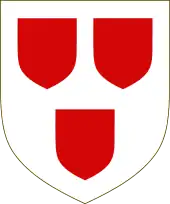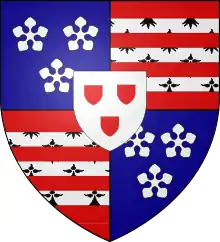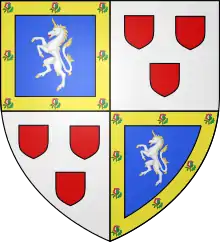Clan Hay
Hay ist der Name eines schottischen Clans, der eine wichtige Rolle in der schottischen Geschichte und Politik gespielt hat. Mitglieder des Clans können in den meisten Teilen Schottlands und in vielen anderen Teilen der Welt gefunden werden. Das Herz der Hay Familie liegt im Nordosten Schottlands, in Aberdeenshire, Banffshire, Morayshire und Nairnshire, während auch andere Distrikte wie Perthshire, die Scottish Borders und die Shetlandinseln eine hohe Zahl Mitglieder aufweisen.
| ||||||||||||||||||
| ||||||||||||||||||
| ||||||||||||||||||
| ||||||||||||||||||
Geschichte
Der Name des Clans geht auf mehrere Dörfer auf der Cotentin-Halbinsel in der Normandie zurück, die La Haye genannt wurden.[16][17] Das Wort haye stammt von haia (übersetzt: Hecke) und wird heute in Frankreich haie geschrieben.[16] Es kann theoretisch auch „Palisade“ gemeint sein,[17] aber aufgrund der für die Normandie charakteristische Heckenlandschaft (Bocage)[18], wird diese Übersetzung hier eher vernachlässigt. Die ursprünglich französische Bezeichnung de la Haye[19] erscheint in lateinischen Texten als de Haya[17][20][21] und entwickelte sich so allmählich im Englischen zu Hay.[17][21] and rendered into Gaelic as Garadh.[17][21] Laut George Fraser Black war MacGaradh (die gälische Form von Hay) nur eine Erfindung von John Hay Allan, auch bekannt als John Sobieski Stuart, Autor des fragwürdigen Vestiarium Scoticum[22]
Chief
Merlin Sereld Victor Gilbert Hay, 24. Earl of Erroll, Lord Hay, Lord Slains, Baronet und Chief of the Name and Arms of Hay[23]
Übersicht
- Hay of Erroll:
- 1449: 1. Baron Hay of Erroll (Sir William Hay, ?–1462)
- 1453: 1. Earl of Erroll (Sir William Hay, ?–1462)
- 1462: 2. Earl of Erroll (Nicholas Hay, ?–1470)
- 1470: 3. Earl of Erroll (William Hay, ?–1507)
- 1507: 4. Earl of Erroll (William Hay, ?–1513)
- 1513: 5. Earl of Erroll (William Hay, ?–1541)
- 1541: 6. Earl of Erroll (William Hay, 1521–1541)
- 1541: 7. Earl of Erroll (George Hay, ?–1573)
- 1573: 8. Earl of Erroll (Andrew Hay, ?–1585)
- 1585: 9. Earl of Erroll (Francis Hay, 30. April 1564–16. Juli 1631)
- 16. Juli 1631: 10. Earl of Erroll (William Hay, ?–1636)
- 1636: 11. Earl of Erroll (Gilbert Hay, ?–1675)
- 1675: 12. Earl of Erroll (John Hay, ?–1704)
- 1704: 13. Earl of Erroll (Charles Hay, ?–1717)
- 1717: 14. Countess of Erroll (Mary Hay, ?–19. August 1758)
- 19. August 1758: 15. Earl of Erroll (James Hay, 20. April 1726–3. Juli 1778)
- 3. Juli 1778: 16. Earl of Erroll (George Hay, 1767–1798)
- 1798: 17. Earl of Erroll (William Hay, 1772–1819)
- 1819: 18. Earl of Erroll (William George Hay, 1801–1846)
- 1846: 19. Earl of Erroll (William Harry Hayl, 1823–1891)
- 1891: 20. Earl of Erroll (Charles Gore Hay, 1852–1927)
- 1927: 21. Earl of Erroll (Victor Alexander Sereld Hay, 1876–1928)
- 1928: 22. Earl of Erroll (Josslyn Victor Hay, 1901–1941)
- 1941: 23. Countess of Erroll (Diana Denyse Hay, 5. Januar 1926–16. Mai 1978)
- 16. Mai 1978: 24. Earl of Erroll (Merlin Sereld Victor Gilbert Hay, 20. April 1948–heute)
- Hay of Kinfauns:
- 4. Mai 1627: 1. Lord Hay of Kinfauns (George Hay, 1571–16. Dezember 1634)
- 4. Mai 1627: 1. Viscount Dupplin (George Hay, 1571–16. Dezember 1634)
- 25. Mai 1633: 1. Earl of Kinnoull (George Hay, 1571–16. Dezember 1634)
- 16. Dezember 1634: 2. Earl of Kinnoull (George Hay, ?–1644)
- ...
- 1709: 7. Earl of Kinnoull (Thomas Hay, 1660–1719)
- ...
- 1938: 15. Earl of Kinnoull (Arthur William George Patrick Hay, 1935–2013)
- Hay of Cromlix:
- 5. Oktober 1718: 1. Earl of Inverness (John Hay, 1691–1740)
- 5. Oktober 1718: 1. Viscount of Innerpaphrie (John Hay, 1691–1740)
- 5. Oktober 1718: 1. Lord Cromlix and Erne (John Hay, 1691–1740)
- Hay of Pedwardine:
- 31. Dezember 1711: 1. Baron Hay of Pedwardine (George Hay, ?–29. Juli 1758)
- Hay of Sawley:
- 29. Juni 1615: 1. Baron Hay of Sawley (James Hay, 1580–25. April 1636)
- 1622: 1. Earl of Carlisle (James Hay, 1580–25 April. 1636)
- 25. April 1636: 2. Earl of Carlisle (James Hay, 1612–30. Oktober 1660)
- Hay of Yester:
- 29. Januar 1488: 1. Lord Hay of Yester (John Hay, 1450–Oktober 1508)
- Oktober 1508: 2. Lord Hay of Yester (John Hay, ?–9. September 1513)
- 9. September 1513: 3. Lord Hay of Yester (John Hay, ?–1543)
- 1543: 4. Lord Hay of Yester (John Hay, ?–1557)
- 1557: 5. Lord Hay of Yester (William Hay, ?–August 1586)
- August 1586: 6. Lord Hay of Yester (William Hay, ?–10. Mai 1591)
- 10. Mai 1591: 7. Lord Hay of Yester (James Hay, ?–3. Februar 1609)
- 3. Februar 1609: 8. Lord Hay of Yester (John Hay, 1593–1653)
- 1646: 1. Earl of Tweeddale (John Hay, 1593–1653)
- 1653: 2. Earl of Tweeddale (John Hay, 1626–1697)
- 1694: 1. Marquess of Tweeddale (John Hay, 1626–1697)
- 1697: 2. Marquess of Tweeddale (John Hay 1645–1713)
- 1714: 1. Lord of Hay of Newhall (William Hay, 1689–31. Oktober 1723)
- 31. Oktober 1723: 2. Lord of Hay of Newhall (John Hay, ?–1743)
- 1743: 3. Lord of Hay of Newhall (George Hay, ?–1787)
- 1787: 4. Lord of Hay of Newhall (William Hay, ?–?)
- 17..: 5. Lord of Hay of Newhall (Edward Hay, ?–?)
- 17..: 6. Lord of Hay of Newhall (John Hay Mackenzie, ?–1749)
- 1749: 7. Lord of Hay of Newhall (George Hay, ?–1876)
- 1714: 1. Lord of Hay of Newhall (William Hay, 1689–31. Oktober 1723)
- ...
- 2005: 14. Marquess of Tweeddale (Charles David Montagu Hay 1947–heute)
- 1697: 2. Marquess of Tweeddale (John Hay 1645–1713)
- 1694: 1. Earl of Gifford
- 1694: 1. Viscount of Walden
- 1881: 1. Baron Tweeddale, of Yester in the County of Haddington
- 29. Januar 1488: 1. Lord Hay of Yester (John Hay, 1450–Oktober 1508)
Schlösser
- Delgatie Castle, Aberdeenshire, wurde dem Clan Hay nach der Schlacht von Bannockburn im Jahre 1314 geschenkt.
 New Slains Castle, Aberdeenshire, befand sich im Besitz des Clans von 1597 bis 1916.[24]
New Slains Castle, Aberdeenshire, befand sich im Besitz des Clans von 1597 bis 1916.[24]
 (Old Slains Castle, Aberdeenshire, Ruine)
(Old Slains Castle, Aberdeenshire, Ruine)
- Dupplin Castle, bei Perth, Perth and Kinross
- Duns Castle, Berwickshire
- Inshoch Castle, Nairnshire
 Megginch Castle, bei Perth, Perth and Kinross
Megginch Castle, bei Perth, Perth and Kinross- Neidpath Castle, Peebles, Ruine
 Park Castle, Dumfries and Galloway
Park Castle, Dumfries and Galloway Yester Castle, East Lothian
Yester Castle, East Lothian
Wappen der Linien von Hay
 Wappen des Earl of Erroll of Erroll |
 Wappen der Hay of Leys of Leys |
 Wappen der Hay of Seafield of Seafield |
 Wappen der Hay of Fudie of Fudie |
 Wappen der Hay of Cardenie of Cardenie |
|||||
 Wappen der Hay of Urie of Urie |
 Wappen der Hay of Alderston of Alderston |
 Wappen der Hay of Dalgety of Dalgety |
 Wappen der Hay of Megginch of Megginch |
 Wappen der Hay of Leith of Leith |
|||||
 Wappen der Hay of Park of Park |
 Wappen der Hay of Naughton of Naughton |
 Wappen der Hay of Strowie of Strowie |
 Wappen der Hay of Pitfour of Pitfour |
 Wappen der Hay of Newhall of Newhall |
|||||
 Wappen der Hay of Laxfirth of Laxfirth |
 Wappen der Hay of Letham of Letham |
||||||||
 Wappen der Hay of Boyne of Boyne |
 Wappen der Hay of Locherworth of Locherworth |
 Wappen der Hay of Broxmouth of Broxmouth |
|||||||
 Wappen der Marquess of Tweeddale of Tweeddale |
 Wappen des Lord Hay of Yester of Yester |
 Wappen der Hay of Linplum of Linplum |
 Wappen der Hay of Smithfleld and Haystoun of Smithfleld and Haystoun |
||||||
 Wappen der Hay of Kinnoull of Kinnoull |
 Wappen der Kent Hay Atkins | ||||||||
 Wappen der Hay of Leys of Leys |
 Wappen der Hay of Pitfour of Pitfour |
 Wappen der Hay of Seggieden of Seggieden | |||||||
 Wappen der Hays |
 Wappen der Hay of Errol of Errol |
 Wappen der Hay of Tweeddale of Tweeddale |
Trivia
Die schwäbische Uradelsfamilie Urslingen führte einen gleichen Wappenschild.
Literatur
- George F. Black: The Surnames of Scotland. Their Origin, Meaning, and History. Reprinted edition. New York Public Library, New York NY 1946.
- John Keegan: Six Armies in Normandy. From D-day to the Liberation of Paris. Penguin Books, Harmondsworth u. a. 1983, ISBN 0-14-005293-3.
- Marquess de Ruvigny: Hay, Marquess of Tweeddale. In: James Balfour Paul (Hrsg.): The Scots Peerage. Band 8: Somerville–Winton. David Douglas, Edinburgh 1911, S. 416–474 (englisch, Textarchiv – Internet Archive).
- Dana F. Sutton: Hector Boethius, Scotorum Historia (1575 version). A hypertext critical edition. 2010, (online). Abgerufen am 5. November 2016.
- Dana F. Sutton: George Buchanan, Rerum Scoticarum Historia (1582). A hypertext critical edition. 2003, revised 2009, (online). Abgerufen am 5. November 2016.
- Peter Townend (Hrsg.): Burke's Genealogical and Heraldic History of the Peerage, Baronetage and Knightage. 105th edition. Burke's Peerage, London 1970.
- Anthony R. Wagner: The Origin of the Hays of Erroll. In: The Genealogist's Magazine. 11, 1954, ISSN 0016-6391, S. 535–40, und 12, 1955, S. 1–6.
- Donald Whyte: Scottish Surnames and Families. Birlinn, Edinburgh 1996, ISBN 1-874744-39-4.
Weblinks
- Clan Hay Society–Offizielle Website
- Clan Hay Society (ehem. offizielle Clan Hay Website–ca. 1998–2010)
- Clan Hay Society–Amerikanischer Zweig
- Clan Hay Society–Kanadischer Zweig
- Die Clan Hay Pipe Band
- Das Hay DNA Projekt
- Clan Hay page in The Standing Council of Scottish Chiefs Website
- Clan Hay page in Armoria Familia Website (Memento vom 22. Oktober 2009 im Internet Archive)
- Die Hay Familie in Schottland
- Peerage ao Hay families
- Abzeichen der Hay Familie
- Hay's Wappen
Einzelnachweise
- clanchiefs.org (Memento des Originals vom 26. Juli 2011 im Internet Archive) Info: Der Archivlink wurde automatisch eingesetzt und noch nicht geprüft. Bitte prüfe Original- und Archivlink gemäß Anleitung und entferne dann diesen Hinweis.. clanchiefs.org. Abgerufen am 19. September 2011.
- John Burke: A Genealogical and Heraldic History of the Commoners of Great Britain and Ireland. Henry Colburn, London 1836, Textarchiv – Internet Archive S. 504.
- John Burke: A Genealogical and Heraldic History of the Commoners of Great Britain and Ireland. Henry Colburn, London 1836, Textarchiv – Internet Archive S. 507.
- John Burke: A Genealogical and Heraldic History of the Commoners of Great Britain and Ireland. Henry Colburn, London 1836, Textarchiv – Internet Archive S. 507–508.
- John Burke: A Genealogical and Heraldic History of the Commoners of Great Britain and Ireland. Henry Colburn, London 1836, Textarchiv – Internet Archive S. 509.
- Marquess de Ruvigny: Hay, Marquess of Tweeddale. In: James Balfour Paul (Hrsg.): The Scots Peerage. Band 8: Somerville–Winton. David Douglas, Edinburgh 1911, S. 416–474 (englisch, Textarchiv – Internet Archive – hier S. 416).
- Marquess de Ruvigny: Hay, Marquess of Tweeddale. In: James Balfour Paul (Hrsg.): The Scots Peerage. Band 8: Somerville–Winton. David Douglas, Edinburgh 1911, S. 467 (englisch, Textarchiv – Internet Archive).
- Marquess de Ruvigny: Hay, Marquess of Tweeddale. In: James Balfour Paul (Hrsg.): The Scots Peerage. Band 8: Somerville–Winton. David Douglas, Edinburgh 1911, S. 454 (englisch, Textarchiv – Internet Archive).
- Marquess de Ruvigny: Hay, Marquess of Tweeddale. In: James Balfour Paul (Hrsg.): The Scots Peerage. Band 8: Somerville–Winton. David Douglas, Edinburgh 1911, S. 460 (englisch, Textarchiv – Internet Archive).
- Marquess de Ruvigny: Hay, Marquess of Tweeddale. In: James Balfour Paul (Hrsg.): The Scots Peerage. Band 8: Somerville–Winton. David Douglas, Edinburgh 1911, S. 456 (englisch, Textarchiv – Internet Archive).
- Marquess de Ruvigny: Hay, Marquess of Tweeddale. In: James Balfour Paul (Hrsg.): The Scots Peerage. Band 8: Somerville–Winton. David Douglas, Edinburgh 1911, S. 449 (englisch, Textarchiv – Internet Archive).
- Marquess de Ruvigny: Hay, Marquess of Tweeddale. In: James Balfour Paul (Hrsg.): The Scots Peerage. Band 8: Somerville–Winton. David Douglas, Edinburgh 1911, S. 450 (englisch, Textarchiv – Internet Archive).
- Marquess de Ruvigny: Hay, Marquess of Tweeddale. In: James Balfour Paul (Hrsg.): The Scots Peerage. Band 8: Somerville–Winton. David Douglas, Edinburgh 1911, S. 451 (englisch, Textarchiv – Internet Archive).
- Marquess de Ruvigny: Hay, Marquess of Tweeddale. In: James Balfour Paul (Hrsg.): The Scots Peerage. Band 8: Somerville–Winton. David Douglas, Edinburgh 1911, S. 435 (englisch, Textarchiv – Internet Archive).
- Iain Moncreiffe of that Ilk: The Highland Clans. The Dynastic Origins, Chiefs and Background of the Clans and some of other Families connected with Highland History. New revised edition. Barrie & Jenkins, London 1982, ISBN 0-09-144740-2, S. 188.
- Black: The Surnames of Scotland. Their Origin, Meaning, and History. Reprinted edition. 1946, S. 350.
- Townend (Hrsg.): Burke's Genealogical and Heraldic History of the Peerage, Baronetage and Knightage. 105th edition. 1970, S. 949.
- Keegan: Six Armies in Normandy. 1983, S. 152.
- manchmal de la Haya oder de la Hay.
- manchmal de Haia.
- Whyte: Scottish Surnames and Families. 1996, S. 88.
- Black: The Surnames of Scotland. Their Origin, Meaning, and History. Reprinted edition. 1946, S. 494–495.
- burkes peerage. Abgerufen am 16. Januar 2013.
- New Slains Castle bei Cruden Bay. Aboutaberdeen.com (16 June 2007). Abgerufen am 19. September 2011